The Ramayana: Ram and Sitas' 14 year Exile. India
In the forests of India near Chitrakoot
The Ramayana is one of the two great Hindu epics, alongside the Mahabharata. It tells the story of Rama, one incarnation of the god. It consists of 24,000 verses divided into seven books, called kandas. It has been an influential sacred text within Hinduism for centuries, with Rama serving as a model of devotion to dharma, or virtue. “Ramayana,” or “The Journey of Rama,” is one of the most compelling Indian epics written by sage Valmiki, who is called the adi kavi, meaning the “first poet” in Sanskrit. It is the story of Rama. The entire life story of Rama, Sita and their companions allegorically discusses duties, rights and social responsibilities of an individual. It illustrates dharma and dharmic living through model characters.
it is so ancient that many Hindus call it Adikavya, meaning "first poem".
The King of Ayodhya, blessed with three wives, fathered four sons. Rama, the eldest, stood among his brothers, which included the twins Lakshmana and Shatrughna, as well as Bharata. Amidst many princes vying for her hand, Princess Sita was tasked with choosing a bridegroom. The challenge was to string a massive bow, a feat effortlessly accomplished by Rama, who not only strung it but also broke it. Sita, captivated by his strength and virtue, chose Rama as her husband, marking their union with a garland and setting a paradigm of love for the kingdom.
Upon the ceremony of namine Prince Rama regent of Ayodhya. 12 years after his wedding, an aging Dasharatha wishes to crown Rama. He calls a council, and all the gathered lords agree Rama should be king ....a to Sita after him, praising Ramas dharma. Rama and Sita prepare for the ceremony. However, one of Dasharathas wives, Kaikeyi, persuaded by evil serving woman becomes jealous.
Kaikeyi and Manthara plot to install Bharata as regent. On the pretext of an old boon owed by Dasharatha, Kaikeyi demands that the king exile Rama for 14 years and pass the throne to her son. Bharata. Dasharatha is bound by his devotion to dharma and must keep his word to fulfill Kaikeyis request. Displaying his own perfect devotion to dharma, Rama accepts his father's decision. Lakshmana and Sita follow him into exile. Bharata, refuses to accept the throne. Instead, he places Rama's sandals on the throne and reigns as his brothers regent, awaiting Ramas' return.
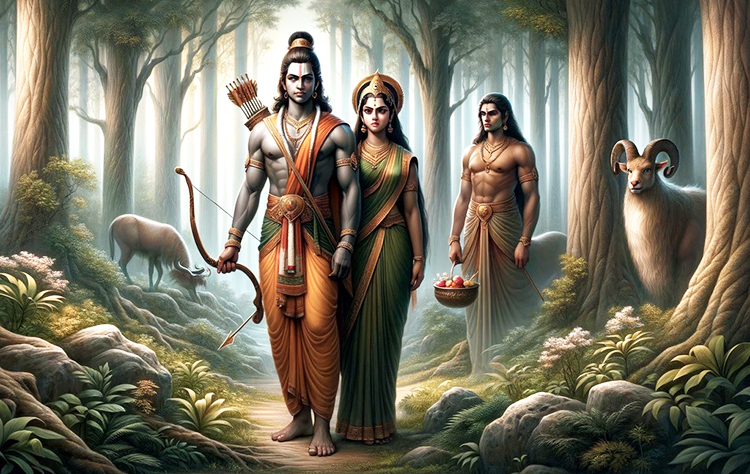
Rama, Sita, Laxman: exiled from Ayodhya.
Ram, Sita, and Lakshman were exiled from Ayodhya and spent years in exile at Chitrakoot. During their exile in the woods, Ram, Sita, and Lakshman walked from Chitrakoot to India’s huge Dandakaranya forest, according to the scripture. According to Ramayana, the trio spent 11 years in this forest. The period that Rama, Sita, and Lakshmana spent near Chitrakoot during their exile is an important chapter in the epic Ramayana. This phase of their life in the forest is marked by simplicity, harmony with nature, and deep spiritual growth, despite being a time of exile and separation from their royal life in Ayodhya.
Chitrakot, located on the border of Uttar Pradesh and Madhya Pradesh in India, is considered a holy place. The natural beauty and tranquility of this area, with its forests, rivers, and hills, provided an ideal hermitage for the trio. The serene surroundings of Chitrakoot, far removed from the luxuries and politics of palace life, offered them a chance to lead a life of asceticism and contemplation.
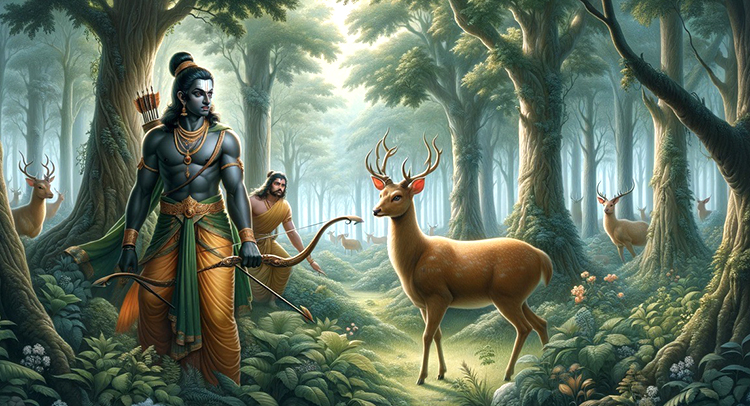
Chitrakoot forest where the Ramayana unfolded
Ram, while in exile, did much work with sages and masts in the jungles. Such God-intoxicated persons as masts always exist on earth, especially in the East, and during Avataric advents they are contacted by God personified. ..
Chitrakoot means ‘the hill of many wonders’, and is the site of ‘Bharat Milap’ where Bharat informed Lord Rama of Dashratha's demise and persuaded Rama to return to Ayodhta and claim his rightful throne. When Rama refused, Bharat took his padukas (slippers) with him to Ayodhya to place on the throne until Rama’s return to the kingdom. According to popular belief this site was also blessed by the gods while Lord Rama was performing the Shraddha ceremony (last rites) of his father here. This period was marked by interactions with many sages and hermits living in the forest. One of the most poignant episodes during this period was the visit of Bharata, Rama's brother. Bharata came to Chitrakoot to persuade Rama to return to Ayodhya and claim his rightful place as king. Rama, however, refused to return before completing his exile, as per his father's wishes. After spending about 11 years in Chitrakoot, their life took a dramatic t leading them to leave Chitrakoot. This incident marked the end of this peaceful chapter and the beginning of a more tumultuous phase in their exile.
The time spent in Chitrakoot is often remembered as a period of idyllic peace and spiritual growth, forming a stark contrast to the trials and challenges that followed in the later part of their exile.
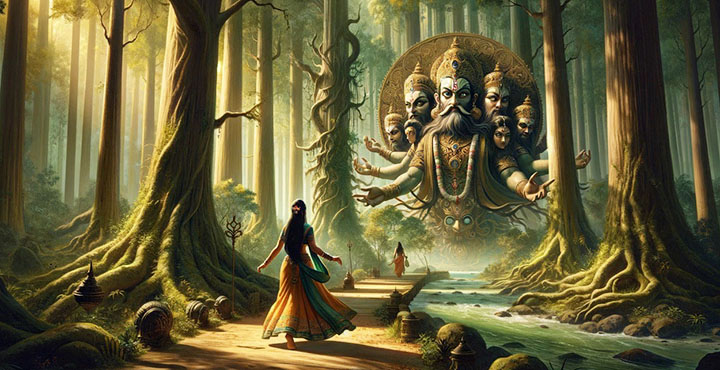
Nashik: Ravana lures Sita out of her magic circle.
Sita and Lakshmana accompanied him on his exile. Ram and Sita and Laxman traveled to the Nasik Forest. Nashik is a city steeped in legend and sits 2,300 feet above sea level. It is significant in the Ramayana because it is where Sita was taken by the demon king Ravana. One day Rama and Lakshmana wounded a demon princess. She returned to her brother Ravana, ruler of Lanka. Ravana sent one of his demons disguised as a magical golden deer to entice Sita. Rama and Lakshmana went out to find the dear, they drew a protective circle around Sita and told her that she would be safe if she did not step outside the circle.
Ravana appeared as a holy man begging alms. Ravana, in his disguise. Moved by the supposed hermit's plight, Sita, unaware of his true identity, decided to step out of the circle to offer alms. The moment Sita stepped out of the protective circle, Ravana shed his disguise and revealed his true form. He then abducted her.
This story is symbolic of the themes of deception, duty, and the battle between good and evil that are central to the Ramayana. This occured in the forest in Nashik.
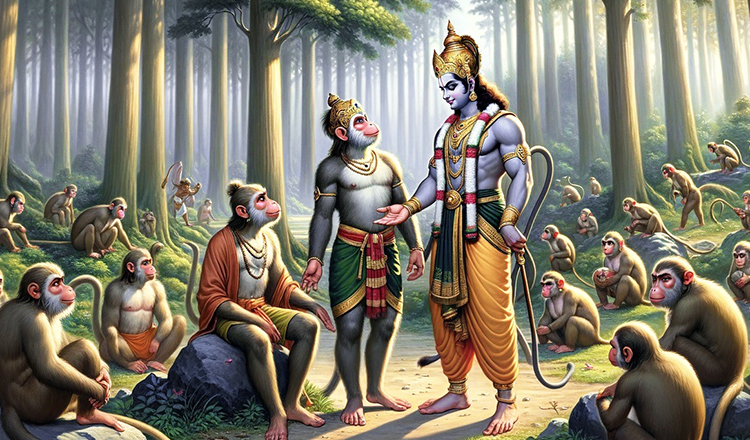
Rama meets Hanuman in Hampi
Hampi, Karnataka. Located along the Tungabhadra River in the east and center part of the state, Hampi is near the city of Hosapete. Kishkindha is where Ram met Hanuman and other Vanara (monkeys) and organised his army, the Vanarsena, with the assistance of Sugriva. This kingdom is now defined as the area around the Tungabhadra river near Hampi. Rama, aided by his Hanuman and an army of monkeys, launches an epic quest to rescue her.
Sita stepped outside the circle to give him food. Ravana grabbed her and carried her to his kingdom in Lanka. Rama then sought the help of a band of monkeys to help him find Sita. In the epic Indian tale of the Ramayana, Ravana, the demon king of Lanka, devised a cunning plan to abduct Sita, the wife of Rama. Ravana knew about the magic circle, or Lakshman Rekha, drawn by Rama's brother Lakshman to protect Sita during their absence in the forest.
-
earch for Sita: After Sita's abduction, Rama and Lakshmana began a desperate search for her. They roamed through forests and met various sages and animals seeking information about Sita's whereabouts.
-
Meeting Hanuman: Rama and Lakshmana's search led them to Hanuman, the monkey deity and a devotee of Lord Rama. They met Hanuman through Sugriva, the exiled monkey king. Hanuman became a devoted follower of Rama and played a crucial role in the search for Sita.
Shabari continued to live in the ashram awaiting Rama. 13 years passed by and Shabari became an old woman and finally Lord Rama came to the place and stopped at the ashram on his journey to Lanka. She proceeded to feed Rama and his brother Lakshmana. Touched by her piety Rama and Lakshmana bowed down at her feet. Then, they narrated to her the incident of Sita's kidnapping and Shabari suggested that they seek help from Hanuman and Sugriva of the monkey kingdom who lived further south near the Pampa lake.
-
Alliance with Sugriva: Rama helped Sugriva regain his kingdom from his brother Vali, and in return, Sugriva vowed to assist Rama in finding Sita. He organized his monkey troops for the search mission.
-
Hanuman's Leap to Lanka: Hanuman, with his divine powers, leaped across the ocean to Lanka. There, he found Sita in Ashoka Vatika, a garden in Ravana's palace. He delivered Rama's message to her and reassured her that Rama would soon come to her rescue.
Hanuman's Encounter with Ravana: Before leaving Lanka, Hanuman allowed himself to be captured by Ravana's forces to get a chance to assess Ravana's strength and deliver a warning. He was set on fire, but he used this to his advantage and set fire to parts of Lanka before returning to Rama.
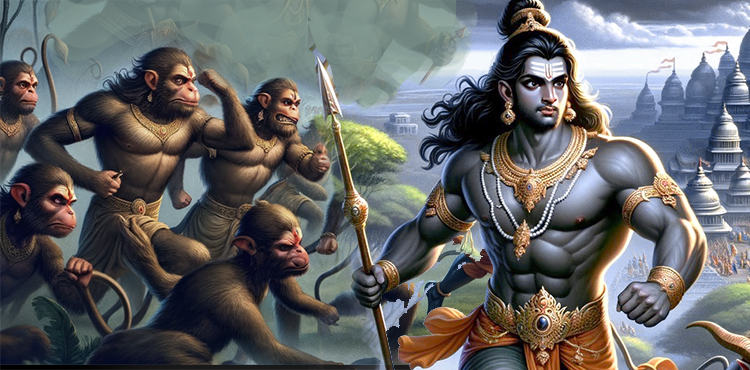
Rama defeats Ravana and rescues Sita.
The epic narrative of Ramayana vividly describes the heroic deeds of Hanuman, the monkey general with the ability to fly, thanks to his divine lineage as the son of the wind. He soared across to Lanka and discovered Sita in captivity, offering her solace and hope. His subsequent capture and daring escape, marked by a trail of fire across the rooftops of Lanka, are episodes of high drama and spectacle in the saga.
Informed of Sita's location, Rama, accompanied by Lakshmana and the monkey army, ventured across the bridge to Lanka. There, a titanic battle unfolded, culminating in Rama's victory over Ravana and Sita's liberation. The Battle in Lanka: A fierce battle ensued between Rama's army and Ravana's forces. Many heroic deeds and tragic events unfolded during this battle.
Rama's Victory Over Ravana: The battle culminated in a direct conflict between Rama and Ravana. Rama, aided by divine weapons and the strategic advice of the wise Vibhishana (Ravana's brother who joined Rama's side), eventually killed Ravana, thus ending his tyrannical rule. This epic journey and battle not only symbolize the victory of good over evil but also showcase the values of loyalty, bravery, righteousness, and the power of devotion.
-
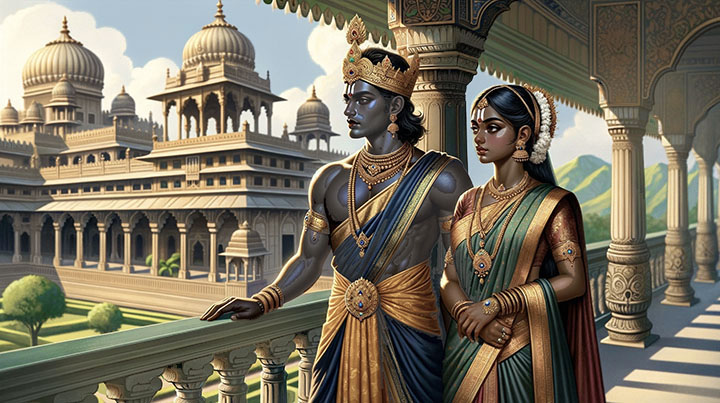
Rama and Sita return to Ayodya
Reunion and Return: After Ravana's defeat, Rama was reunited with Sita. Completing his 14-year exile, before returning to Ayodhya, Sita proved her purity by undergoing a trial by fire.
Sita enters a burning pyre declaring that if she has been faithful to Rama let the fire not harm her; she comes out unscathed with the fire-god Agni as proof of her purity. Rama accepts Sita back and returns to Ayodhya, where they are crowned as king and queen.
They returned to Ayodhya in the flying chariot Pushpaka Vimana, where Rama was crowned king, marking the beginning of Ram Rajya, an era of peace and justice.
Rama defeats evil and light returns. Diwali 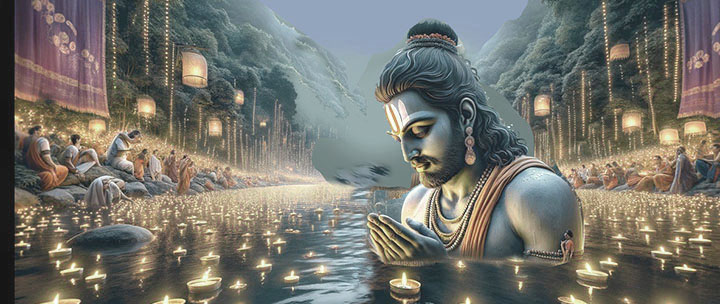
His return is celebrated as Diwali, the Festival of Lights, in India. Upon his return, Rama was crowned as the king of Ayodhya. His reign is considered the golden era of righteousness and prosperity, known as "Ram Rajya," where justice and welfare prevailed throughout the kingdom.
The questioning of Sita's purity by the people of Ayodhya is one of the most poignant and complex episodes in the Ramayana. After Rama and Sita returned to Ayodhya and Rama was crowned king, they enjoyed a period of happiness.
However, doubts about Sita's chastity and purity arose among the citizens of Ayodhya due to her long captivity in Ravana's Lanka. Sita's time in the abode of Ravana led to public speculation. The gossip and doubt amongst his subjects troubled Rama. People in Rams' kingdom questioned Sitas' purity. When Rama was vulnerable the most, torned between his people and his wife, it was Sita who may have volunteered her exile. She knew that even if her husband would abandon their kingdom to be with her, Rama would always feel guilty for not serving to his people altruistically. Thereafter, against her husband's will, she goes into exile. Rama had never questioned Sita's character, as he believes her to be pure.
Common version: Abandonment when she’s sent off to the forest although she’s pregnant. A t 28, he goes into exile for 14 years to return when he is 42 years. “If this is true, then during the twelve years of marriage …and thirteen years of exile…
After leaving Ayodhya, Sita found refuge in the hermitage of sage Valmiki, the author of the Ramayana. Here, she gave birth to her twin sons, Luv and Kush. Valmiki provided shelter and guidance to Sita and her sons, and it was in his hermitage that Luv and Kush were educated and trained in various arts, including archery and the knowledge of the Vedas. Luv and Kush grew up to be wise and valiant youths,
They eventually came into contact with Rama during an Ashwamedha Yagya, The twins challenged the authority of Rama without initially knowing that he was their father. It was only later during a confrontation in Rama's court that their identity was revealed, leading to a reunion.
Sita, after proving her purity once again, made the ultimate decision to return to Mother Earth, her mother, as a final assertion of her purity and dignity. This act of returning to the earth is seen as a powerful and symbolic end to her trials and tribulations, representing a form of divine validation of her innocence and sanctity.
-
------------------------------------------------------------------------------------------
Chitrakoot Now. You can take a 6-7 hour train ride to Chitrakoot /Chitrakot from Varanasi. Ram and Sita stayed there and Sita often bathed in the river there. Actually, it is believed to be an asylum for Lord Rama and His consort Sita for over a decade, eleven years and a half during their exile period. Ram, while in exile, did much work with masts in the jungles. Such God-intoxicated persons as masts always exist on earth, especially in the East, and during Avataric advents they are contacted by God personified. .. Many Temples to see and boat rides on the River. Arti on Ram Ghat is nice. Very nice and reasonable hotels in town. You could then take a 6-7 hour train ride to Agra to continue your journey.
Ayodhya now: as the birthplace of Rama, Ayodhya has been regarded as a most important pilgrimage site for Hindus. Topographical indications in both Buddhist and Jain texts suggest that Saketa is the same as the present-day Ayodhya. The city remained deserted until King Vikrama of Ujjain came searching for it, and re-established it. He cut down the forests that had covered the ancient ruins, erected the Ramgar fort, and built 360 temples. It is believed that a temple stood at the birth place of Rama, which was demolished by the orders of the Mughal emperor Babur in 1528 A.D. and a mosque erected in its place.
Ayodhya NOW: No trip to Ayodhya is complete without a visit to ghats of the sacred Saryu river, where it is believed Rama took his last dip and was never seen again in human form. It is also believed he bathed in the river after defeating Ravana. You can take a boat ride on the River Saryu, which is known to be the abode of hundreds of dolphins! ( Platanista Gangetica). The species is endemic to the Gangetic river system.
King Rama after Sita left
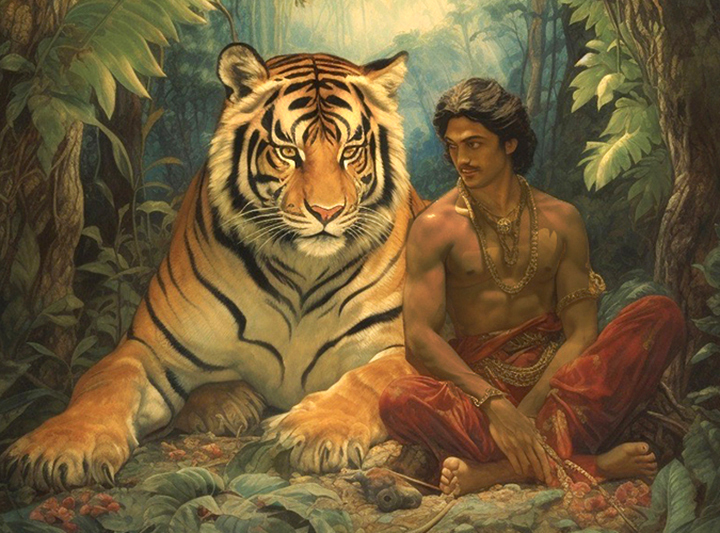
In a final, dramatic assertion of her purity and dignity, Sita makes a heartrending appeal to the Earth, her mother, to receive her if she has remained faithful and pure. In response, the Earth miraculously parts, welcoming Sita into its embrace, thus affirming her virtue in the most definitive manner. This act serves as a powerful testament to Sita's character, strength, and integrity, and as a poignant commentary on the trials she faced. Her decision not to return to her husband, despite being vindicated, reflects a deep sense of self-respect and a poignant commentary on the societal norms and expectations she faced.
Saryu Rivee in Ayodhya: On the bank, one of the well maintained and super clean ghats of Ram Ki Pairi..Boating on the Saryu is a way to spend some wonderful time.
This temple is dedicated to Lord Hanuman. It holds high religious significance for devotees and is one of the most visited temples. Devotees believe that Lord Hanuman lived in this temple, guarding the Lord Ram's residence.
Kanak Bhawan Temple is one of the finest and famous temples in Ayodhya and is a must visit. It is believed that this Bhawan was gifted to Devi Sita by Kaikei immediately after her marriage to Lord Ram. This is private palace of Devi Sita and Lord Rama. Vikramaditya got it renovated.
|